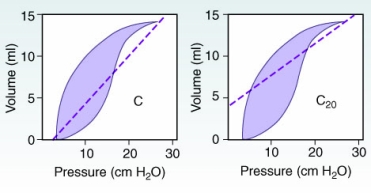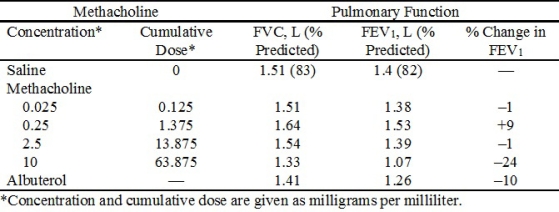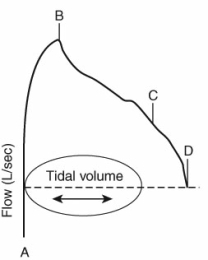A) Neuromuscular disease
B) Abnormal chest wall configuration
C) Interstitial fibrosis
D) Asthma
F) A) and B)
Correct Answer

verified
Correct Answer
verified
Multiple Choice
How should the therapist interpret the following pressure-volume loop obtained from a mechanically ventilated infant?

A) A leak has developed in the ventilator-patient system.
B) The patient's lungs are being overinflated.
C) The patient is displaying trigger dyssynchrony.
D) The patient's lungs are exhibiting increased compliance.
F) C) and D)
Correct Answer

verified
Correct Answer
verified
Multiple Choice
How is airway resistance calculated?
A) By dividing the airway occlusion pressure by the expiratory flow
B) By dividing the transpulmonary pressure by the expiratory flow
C) By multiplying the expiratory flow by the pressure gradient responsible for initiating inspiration
D) By multiplying the expiratory occlusion pressure by the transpulmonary pressure gradient
F) B) and C)
Correct Answer

verified
Correct Answer
verified
Multiple Choice
Which of the following factors is the most important determinant of high airway resistance and air trapping in small infants?
A) The small tidal volume
B) Small diameter of the airways
C) Excessive amount of mucus production
D) The length of the airways
F) C) and D)
Correct Answer

verified
Correct Answer
verified
Multiple Choice
Which of the following major forces opposes inspiration?
A) Inspiratory flow
B) Surface tension
C) Airway resistance
D) Respiratory rate
F) B) and D)
Correct Answer

verified
Correct Answer
verified
Multiple Choice
The therapist is reviewing a flow-volume loop obtained from a pediatric patient and observes decreased volume and normal flows.On the basis of this observation,how should the therapist interpret this finding?
A) Obstructive pattern
B) Restrictive pattern
C) Fixed airway obstruction
D) Variable extrathoracic obstruction
F) A) and C)
Correct Answer

verified
Correct Answer
verified
Multiple Choice
Pulmonary function testing has been ordered in an infant.Which of the following represents a real risk to this infant?
A) The infant may require sedation for up to 3 hours.
B) If the infant cries,it will make the test invalid or open to misinterpretation.
C) The gases used for the PFT may be toxic for the infant.
D) The inability to feed the child 24 hours prior to the test
F) B) and C)
Correct Answer

verified
Correct Answer
verified
Multiple Choice
On the basis of the bronchial provocation data presented in the following table,identify the PD₂₀ (provocative dose that produces a 20% fall in FEV₁) .

A) 0.025 mg/mL
B) 0.25 mg/mL
C) 2.5 mg/mL
D) 10 mg/mL
F) A) and D)
Correct Answer

verified
Correct Answer
verified
Multiple Choice
Which of the following pulmonary function values characterize an obstructive lung defect? I.The forced vital capacity (FVC) may remain normal. II.The forced expiratory volume in 1 second (FEV₁) is decreased. III.The ratio of residual volume to total lung capacity (RV/TLC) may be normal. IV.The FEV₁ is decreased.
A) II and IV only
B) I,II,and III only
C) I,III,and IV only
D) II,III,and IV only
F) B) and C)
Correct Answer

verified
C
Correct Answer
verified
Multiple Choice
On the partial expiratory flow-volume loop shown here,identify the point depicting the "maximal expiratory flow at FRC."

A) A
B) B
C) C
D) D
F) B) and D)
Correct Answer

verified
Correct Answer
verified
Multiple Choice
According to the ATS-ERS acceptability criteria for an FVC maneuver performed on a 9-year-old child,what is considered a satisfactory exhalation time?
A) 1 second
B) 2 seconds
C) 3 seconds
D) 6 seconds
F) A) and C)
Correct Answer

verified
Correct Answer
verified
Multiple Choice
A reduction in the DLCO may indicate the presence of which of the following conditions? I.Pulmonary fibrosis II.Pulmonary edema III.Hematologic disorders IV.Bronchiolitis obliterans
A) I and II only
B) I and III only
C) I,II,and III only
D) I,II,III,and IV
F) None of the above
Correct Answer

verified
Correct Answer
verified
Multiple Choice
A child has been diagnosed with vocal cord dysfunction.Which of the following flow-volume loops demonstrates this condition?
A) Figure 5-9C
B) Figure 5-9A
C) Figure 5-9B
D) Figure 5-8B
F) A) and C)
Correct Answer

verified
Correct Answer
verified
Multiple Choice
What is the clinical purpose for measuring the maximal inspiratory pressure (MIP) ?
A) To assess lung function before and after bronchodilator administration
B) To help patients with asthma management at home
C) To evaluate the strength of respiratory muscles
D) To assist in performing bronchial hygiene techniques
F) All of the above
Correct Answer

verified
C
Correct Answer
verified
Multiple Choice
Why must caution be exercised when using a face mask while performing pulmonary function testing on neonates?
A) To prevent trigeminal nerve stimulation
B) To avoid necrosis of the facial skin
C) To prevent vagal reflexes
D) To prevent gastric insufflations
F) All of the above
Correct Answer

verified
A
Correct Answer
verified
Multiple Choice
On the basis of the data presented below,calculate the time constant. •Tidal volume (VT) ,600 mL •Respiratory rate (RR) ,12 breaths/minute •Lung compliance (C) ,0.2 L/cm H₂O •Airway resistance (Raw) ,2.5 cm H₂O/L/second •Peak inspiratory pressure (PIP) ,30 cm H₂O •Inspiratory time (TI) ,2 seconds •Expiratory time (TE) ,1 second
A) 4.5 seconds
B) 3.0 seconds
C) 0.5 second
D) 0.1 second
F) A) and D)
Correct Answer

verified
Correct Answer
verified
Multiple Choice
The respiratory therapist places a face mask on an infant to measure FRC.What should the therapist do to minimize the presence of air leaks and improve accuracy of the test?
A) Place a nose clip on the infant.
B) Minimize the amount of helium used during the test.
C) Minimize oxygen concentration and increase nitrogen concentration.
D) Apply petroleum jelly on the edges of the mask before applying the mask to the face.
F) B) and D)
Correct Answer

verified
Correct Answer
verified
Multiple Choice
A pre- and postbronchodilator,partial expiratory pressure-volume maneuver was performed on a 9-month-old boy.The child's prebronchodilator mₐₓFRC was 67 mL/second and the postbronchodilator mₐₓFRC was 94 mL/second.How should the therapist interpret these data?
A) The data are erroneous.
B) The data are inconclusive.
C) The patient will not clinically improve with bronchodilator administration.
D) The patient has demonstrated clinically significant improvement with bronchodilator administration.
F) A) and C)
Correct Answer

verified
Correct Answer
verified
Showing 1 - 18 of 18
Related Exams